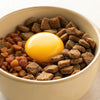Can I Add Rice to Raw Dog Food? A Comprehensive Guide for Pet Owners
- Houndsy
Table of Contents
- Introduction
- Understanding Raw Dog Food
- The Role of Grains in Dog Nutrition
- Can I Add Rice to Raw Dog Food?
- Potential Risks and Considerations
- Conclusion
Introduction
Have you ever looked at your dog’s bowl, filled with tempting raw meat and wondering if adding something extra could improve their diet? If you’ve found yourself asking, "Can I add rice to raw dog food?" you're not alone. Many pet parents explore ways to enhance their dog’s meals, especially when it comes to diverse diets like raw feeding. With more dog owners embracing raw diets, understanding the basics of nutritional balance becomes crucial for canine health and well-being.
In this blog post, we will dive deep into the practice of mixing rice with raw dog food. We will explore the potential benefits and drawbacks, study the role of grains in dog nutrition, and provide practical tips on transitioning to a balanced diet. By the end, you will have a clearer understanding of whether rice can make a healthy addition to your dog's raw food regimen.
So let’s embark on this journey together, assessing the foundational aspects of dog nutrition while simultaneously addressing your concerns about their meals. Your pup’s health is essential, and we’re here to guide you in making informed decisions about their dietary needs.
Understanding Raw Dog Food
What is Raw Dog Food?
Raw dog food is an uncooked alternative to commercial dog food. It typically consists of raw meat, bones, fruits, and vegetables, often designed to mimic what dogs would naturally consume in the wild. Proponents of raw feeding argue that this diet can lead to healthier skin, shinier coats, increased energy levels, and improved digestion. However, transitioning a dog to raw feeding requires knowledge and carefully considered choices.
Benefits of Raw Feeding
-
Nutritional Variety: Raw dog food can provide a wider range of nutrients than processed kibble. This can improve overall health and vitality.
-
Digestibility: Many dogs digest raw food more easily due to the absence of fillers and preservatives commonly found in commercial pet food.
-
Weight Management: Because raw diets are typically tailored to the dog’s specific needs, many owners report better control over their pet’s weight.
-
Dental Health: Chewing raw bones can help reduce plaque and tartar buildup on your dog’s teeth.
Potential Drawbacks of Raw Feeding
-
Bacterial Risks: Raw meat can potentially harbor harmful bacteria like Salmonella and E. coli, which can affect both dogs and their owners.
-
Nutritional Imbalance: If not properly balanced, raw diets can lead to deficiencies in essential nutrients, requiring careful planning and consultation with a veterinarian.
-
Higher Preparation Time: Preparing raw meals requires more time and effort compared to simply pouring kibble into a bowl.
Summary
In essence, while raw diets can be beneficial, they require careful planning to maintain nutritional balance. The next question revolves around whether adding rice can enhance this balance.
The Role of Grains in Dog Nutrition
Are Grains Necessary?
Unlike cats, which are obligate carnivores, dogs are omnivores. This means they can digest and utilize nutrients from both animal and plant sources. While dogs thrive primarily on protein and fat, some carbohydrates, including grains, can be beneficial.
-
Source of Energy: Grains like rice provide a rich source of carbohydrates, which can give your dog the energy they need for daily activities.
-
Digestive Health: Whole grains can promote digestive health due to their fiber content.
-
Allergenic Properties: For some dogs, grains might lead to allergies or sensitivities. This varies from dog to dog.
The Case for Rice
Rice, especially white or brown rice, is often recommended by veterinarians for its bland qualities, making it gentle on the dog's stomach.
-
Gentle on the Stomach: It’s often given to dogs recovering from gastrointestinal issues due to its easy digestibility.
-
Hypoallergenic: Rice is less likely to trigger allergic reactions compared to other grains.
-
Nutritional Value: Cooked rice contains essential carbohydrates and can provide some vitamins and minerals, but it must be balanced with other nutrients.
Can I Add Rice to Raw Dog Food?
Yes, You Can—but with Consideration
Adding rice to raw dog food can indeed be done, but there are key considerations to ensure your dog's diet remains balanced and healthy:
-
Portion Control: If you decide to incorporate rice, moderation is key. This means that rice should not dominate your dog's meals but rather serve as an addition. A general guideline is that carbohydrates should make up no more than 10-20% of your dog’s meal.
-
Health Status: We recommend consulting with your veterinarian before making any significant changes to your dog's diet, especially if they have pre-existing health conditions.
-
Preparation Method: Always cook rice before adding it to your dog’s food to enhance digestibility. Avoid seasonings, as many can be harmful to dogs.
-
Balanced Nutrients: Ensure that the rest of your dog's diet consists of high-quality proteins, healthy fats, and essential vitamins and minerals.
How to Introduce Rice into Your Dog’s Diet
-
Start Slow: Gradually introduce rice into their diet to monitor how they react. A good starting ratio is one part rice to three parts raw food.
-
Mix Well: Ensure that the rice is thoroughly mixed with the raw food to avoid selective eating.
-
Monitor for Changes: Keep an eye on how your dog reacts to the change in diet. If they experience any adverse effects like gastrointestinal upset, stop and consult your veterinarian.
Summary
Incorporating rice into your dog’s raw food diet can provide additional energy and dietary balance. However, it is essential to do so with careful consideration of portion size, preparation, and overall nutritional balance.
Potential Risks and Considerations
Allergies and Sensitivities
As with any ingredient, some dogs may have sensitivities or allergies to rice. It's crucial to observe how your pup reacts after you introduce rice into their diet. Signs of allergies can include:
- Itching
- Gastrointestinal upset
- Ear infections
Balanced Diet
A raw diet that includes rice should not detract from the essential components your dog needs for overall health. Ensure their diet is rich in:
- High-quality animal proteins
- Fats
- Fruits and vegetables that provide vitamins and antioxidants
Veterinary Guidance
Consulting your veterinarian for tailored advice is key, especially if you're considering significant diet changes. They can suggest specific portions and meal combinations catered to your dog's unique health needs.
Conclusion
The question "Can I add rice to raw dog food?" enables us to explore the broader scope of canine nutrition, emphasizing the importance of balance. While rice can be a beneficial addition for many dogs, it must be approached mindfully, ensuring that your dog continues to receive complete and balanced nutrition.
If you’re looking for a way to optimize your dog’s feeding routine while enhancing the aesthetics of your home, consider the Houndsy Kibble Dispenser. Our innovative design allows you to maintain portion control effortlessly, serving as a convenience and a decorative piece in your home. You can explore our product here.
Incorporating healthy practices into your dog’s diet not only benefits them physically but also strengthens the bond you have through shared meal times. As pet owners, we have the unique opportunity to nourish our furry friends and contribute to their overall happiness and health. With careful planning, you can make informed decisions that support your dog's dietary needs.
FAQ
Can I add other grains besides rice to my dog's raw food?
Yes, you can consider grains like quinoa or oats; however, just like rice, moderation is key. Always ensure you have balanced portions and check for any allergies.
How much rice can I safely add to raw dog food?
A good starting point is to ensure that carbohydrates, including rice, account for no more than 10-20% of your dog's total meal.
What if my dog has a sensitive stomach?
If your dog tends to have a sensitive stomach, it’s best to consult your vet first before adding rice or any new ingredient to their diet.
How can I tell if my dog's diet is balanced?
A dog's balanced diet should contain high-quality proteins, fats, carbohydrates, vitamins, and minerals. If you're unsure, your veterinarian can provide a dietary assessment.
Should I cook or serve rice raw?
Always cook rice before serving it to your dog. Raw rice is harder to digest and may lead to an upset stomach.
Through this exploration, we hope you feel empowered to make informed food choices for your furry companion while enhancing your pet feeding routines with style and efficiency through products like the Houndsy Kibble Dispenser. Your dog deserves the best, and we’re here to support you in that journey!












